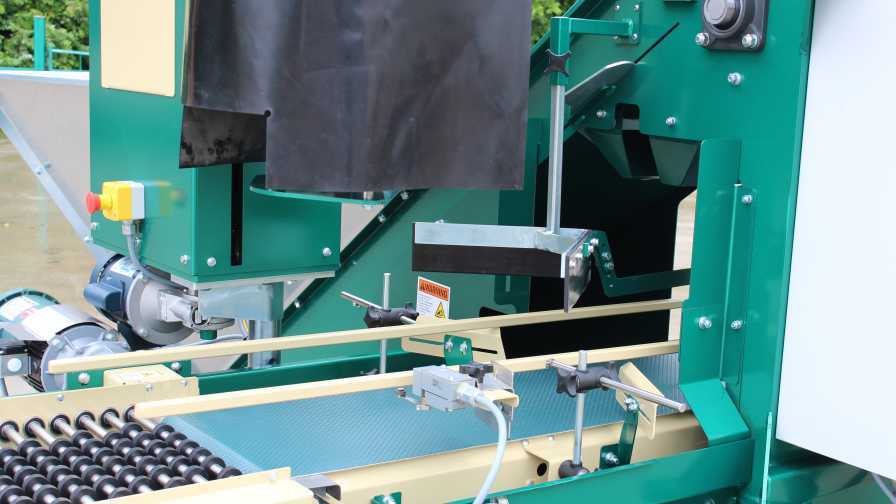How Pot Fillers Can Streamline Production in the Greenhouse

Bouldin & Lawson’s EP 2200 Potting Machine fills and drills 1- to 7-gallon pots. According to the company, these pot fillers have power sweeps and a rotary brush, the same as a standard flat filler, allowing growers to fill flats and cell trays for added flexibility.
As labor and other overhead costs continue to trend up, greenhouse operations need to find new efficiencies to overcome eroding profit margins.
Many growers have found a relative level of success in automating the pot-filling process. Instead of devoting precious labor resources to hand-filling pots, typically a conveyor system moves pots through an overhead loading and soil mixing apparatus, and the labor is merely there to supervise and ensure consistency.
And it’s not limited to using robots and conveyor belts to simply add soil mixes into pots. There are also automation tools that apply water and nutrients to the potted mixes, taking yet another time-intensive aspect out of human hands.
Regardless of the level of automation a grower demands, pot filler manufacturers are being challenged to apply the technology in a holistic fashion. For the grower, it’s all about maintaining flexibility.
“Growers are looking for potting machines that can handle a wide range of tray and pot sizes,” says Jack Ford, AgriNomix Sales Manager. “At the same time, retailers are looking for more place-and-enjoy potted plants in decorative containers, and this creates a challenge for growers as they have to plant into a wide range of container designs and sizes.”
Paul Whiting, President, Bouldin & Lawson, also sees the need for flexibility as the top request among growers looking to do an install.
“Larger containers and larger plants being planted into them require a do-it-all machine,” he says. “A 72-plug all the way through 4-inch and 1-gallon and quart (pot sizes) to be planted requires a machine that can drill single and multiple holes to meet planting pattern needs in one go.”
Emerging Crops
Canada fully legalized cannabis back in 2018, and here in the U.S. legal cannabis and hemp (along with greenhouse grown vegetables) are crops currently exploding with interest on the greenhouse side as regulations ease up and more and more growers look at producing these in-demand segments. “Cannabis growers are a natural for pot fillers,” Ford says. “Most operations fill and plant a fixed number of pots every week, and a potting machine allows them do that consistently.”
“Although daily pot-filling production numbers are typically less than many commercial ornamental greenhouse growers, the need to turn frequently, the lack of a set season, and the desire to keep production staff to a minimum quickly put them onto looking for automation/pot fillers,” adds Whiting.
Whiting says that space can be a limiting factor for both ornamental as well as emerging crop growers in the greenhouse space and having enough room for spacing potted plants remains just as key for cannabis and hemp growers as any other greenhouse crop.
“Generally speaking, existing greenhouse growers already have a handle on good production space, but those getting into cannabis and growing it in the greenhouse for the first time often underestimate the amount of space required. They typically leave too little for actual production, or designers don’t allocate enough during design study,” he says.
Recent Grower Installations
Greenhouse Grower asked Ford and Whiting what they’ve seen and heard from growers when they’ve been on-site for recent installations.
For Whiting, he’s learned that it’s important to make sure growers are thinking about the other infrastructure in place around pot fillers to get the empty pots through the process.
“Some growers are not ready for the increase in production rates per hour, and they either don’t have or will resist putting in the additional infrastructure to get product to the growing area,” he explains. “They quickly realize the need to add conveyors and carts, or in some cases they can redeploy staff now that less are needed to complete given daily production goals.”
Ford and his team at AgriNomix have found that the flexibility growers seek out of pot-filling setups lends itself nicely to add on technologies on the production line. “New technologies that are proving popular items on lines are powered dibblers to set patterns, and consistent planting and long water tunnels to allow for good watering and ample drip-off/takeoff area,” he says.
Parting Pointers
Bouldin & Lawson’s Whiting says growers should avoid the common mistake of underestimating the initial learning curve associated with integrating a new machine into the production process.
“The technology itself and integrating some of these newer machines can sometimes be more involved, and growers sometimes struggle to either pick the right machine or design the system in a manner that is utilizing it in the best way possible,” he says.
Ford adds that keeping an open mind to the different options that are out there when it comes to the soil mix you’re using can also help.
“Make sure that the filler you are looking at works with your soil blend,” he says. “Some fillers have a lot less maintenance with certain soils. Also, think about your future needs so you can grow with or into your potting machine.”










